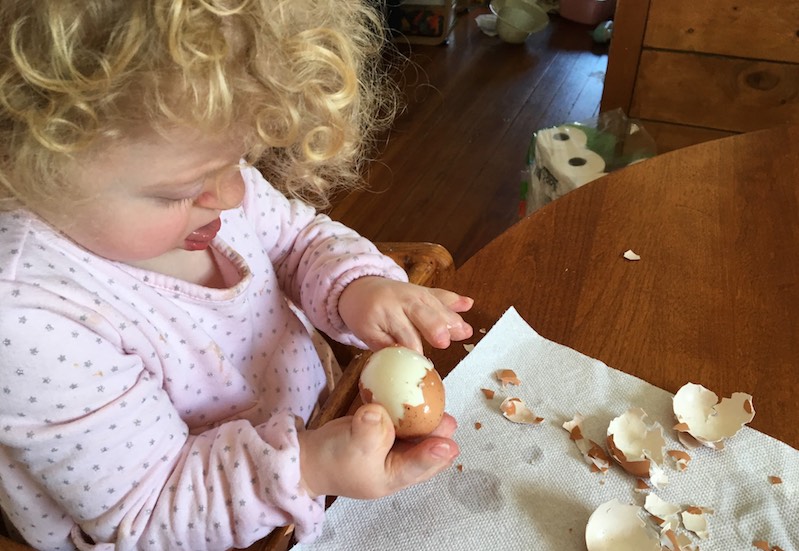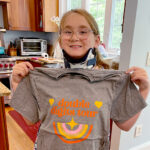Maisie’s story: Our journey with Apert syndrome

Our daughter Maisie is 4 years old. She loves riding her bike, baking, jumping on the trampoline, and keeping up with her older sister, Eliza. She’s also especially skilled at peeling hard boiled eggs.
We learned prenatally at 18 weeks that something was going on with Maisie’s development. My doctors suspected craniosynostosis, a condition where the connections between the bones of the skull, called sutures, grow together too early. This can lead to problems with brain and skull growth.
Seven weeks of waiting
But during the ultrasound, Maisie’s positioning didn’t allow for a clear image of her skull or limbs. So, we spent seven weeks between the ultrasound and diagnosis waiting on multiple tests: a fetal MRI, amniocentesis, chromosomal microarray, and a craniosynostosis genetic sequencing panel. The test results came back in that order, and while we waited we thought it likely that Maisie had non-syndromic craniosynostosis. After all, we learned that 90 percent of all cases are non-syndromic, meaning the craniosynostosis is not associated with any congenital syndrome.
During our wait, my husband, Rob, and I also became comfortable with the idea that Maisie would undergo the standard treatment for non-syndromic craniosynostosis — endoscopic suture release followed by six to nine months of helmet therapy. My understanding was that the endoscopic suture release was a very promising, minimally invasive technique that opened the fused sutures when performed between 2 to 4 months of age. This procedure, in conjunction with the shaping helmet, offered an early opportunity to let the skull and brain grow as normally as possible.

Diagnosis: Apert syndrome
At 25 weeks, we learned Maisie has Apert syndrome, a rare genetic condition in which the skull, face, hands and feet develop abnormally. I started researching Apert syndrome that night. I read as many journal articles as I could get my hands on. I also researched the techniques that different hospitals were offering, and was surprised to find that many hospitals did not consider the endoscopic suture release an option for children with syndromic craniosynostosis.
While I understood that Maisie’s sutures were more susceptible to premature refusion, I still wanted to release the fused coronal sutures as early as safely possible to optimize normal skull and brain growth before they refused. I thought this would be beneficial, even if Maisie needed to undergo a subsequent fronto-orbital advancement.
Based on my research, and after talking with my maternal fetal medicine specialist, I decided to look into three options: a local hospital, Boston Children’s Hospital, and a children’s hospital in Pennsylvania.
We decided not to go with the local hospital because the neurosurgery department did not offer endoscopic suture release for infants with syndromic craniosynostosis.

Finding the Apert Syndrome Symposium
As luck would have it, Boston Children’s, which includes the endoscopic suture release in its Apert syndrome brochure, was holding an Apert Syndrome Symposium shortly after we learned of Maisie’s diagnosis. We attended, and were quickly comforted by the fact that Dr. Mark Proctor, the neurosurgeon-in-chief, was not only willing to perform the procedure, but had been performing this procedure on infants with syndromic craniosynostosis for over five years. After hearing Dr. Proctor and the other members of the craniofacial team discuss the treatments they offer from birth to adulthood, and the interdisciplinary approach they take, we knew our decision was made.
Confident in Maisie’s team in Boston
When we left Boston, I was more relaxed. I knew that we could not control what symptoms Maisie would have, or their severity, but I knew that the team at Boston Children’s could handle it. This was only further confirmed when I watched multiple video clips on the Boston Children’s website of Dr. Proctor and Dr. John Meara, plastic surgeon-in-chief, performing far more complex cranial-facial surgeries. Because we were comfortable with the approach at Boston Children’s, and it is closer to home, we cancelled our consultation with the other hospital.

Maisie did well with her endoscopic suture release, and has not had to have a second surgery. She’s also had a series of three syndactyly surgeries to release her fingers and toes, and separate fused metatarsals, bones in the foot. We elected to do the toe syndactyly release because of my personal experience with having foot surgeries and the impact they had on my own body mechanics. She’s also had a multi-stage thumb lengthening and straightening procedure, which resulted in what she calls her “super thumbs,”and eye surgery to correct strabismus. Her latest acquisition is a pair of bright colored hearing aids that give her “super ears” to go along with her “super thumbs.”
Throughout all of these procedures, we’ve found the care at Boston Children’s to be very reassuring. Maisie requires complex care, and we know that her providers are on top of it and will seamlessly coordinate her care. The support services the hospital offers, including child life and music therapy, have also been a great support — helping keep Maisie calm before surgeries and explaining her complex care to her sister, Eliza, in terms she can understand. It gives us peace of mind to know she has a team we can count on, no matter what.
Learn more about the Department of Neurosurgery.
Related Posts :
-

Minimally invasive surgery safe and effective for craniosynostosis
Traditional treatment for children with craniosynostosis — a condition in which the bones of the skull grow together too early in ...
-

What orthopedic trauma surgeons wish more parents knew about lawnmower injuries
Summer is full of delights: lemonade, ice cream, and fresh-cut grass to name a few. Unfortunately, the warmer months can ...
-

A fall from a swing uncovers a rare cervical spine condition: Charlotte’s story
If it were any other year, Charlotte Gillis would have celebrated her 10th birthday in mid-July with a big party. ...
-

MRI could reduce the mystery of brachial plexus injuries in infants
About one in 1,000 children are born with brachial plexus birth injury (BPBI), upper extremity weakness or paralysis resulting from trauma ...





